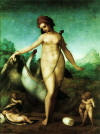Search:: Artists Alphabetically Artists by Country Artists by Century Artists by Movement
Jacopo da Pontormo
1494 - 1557
One of the Greatest Painters Of All Time
Italian, Florentine, Mannerist Painter
Stylistically
influenced by the following painters - Piero
di Cosimo, Leonardo
da Vinci,
Mariotto Albertinelli, Michelangelo and Andrea
del Sarto
Cause of death - unknown
 Biography
Biography
Biography
Jacopo da Pontormo was one of the greatest Italian painters of all time. Even after five hundred years his paintings amaze and mesmerize. His innovative style his sense of colour was entirely original and fresh. He was patronized and commissioned by the Church and nobility. The Medici not only commissioned the painter but invited him to state events and family gatherings.
In Jacopo da Pontormo's declining years he became somewhat reclusive. Giorgio Vasari artist and author of The Lives of the Artists, writes "Jacopo was a frugal and sober man, and in his dress and manner of life he was rather miserly than moderate; and he lived almost always by himself, without desiring that anyone should serve him or cook for him. In his last years, indeed, he kept in his house, as it were to bring him up, Battista Naldini, a young man of fine spirit, who took such care of Jacopo's life as Jacopo would allow him to take; and under his master's discipline he made no little proficiency in design, and became such, indeed, that a very happy result is looked for from him. Among Pontormo's friends, particularly in this last period of his life, were Pier Francesco Vernacci and Don Vincenzio Borghini, with whom he took his recreation, sometimes eating with them, but rarely. But above all others, and always supremely beloved by him, was Bronzino, who loved him as dearly, being grateful and thankful for the benefits that he had received from him."
According to Art Scholar, Bernhard
Berenson "Pontormo, who had it in him to be a decorator and
portrait-painter of the highest rank, was led astray by his awe-struck
admiration for Michelangelo, and
ended as an academic constructor of monstrous nudes. What he could do
when expressing himself, we see in the lunette at Poggio a Caiano, as
design, as colour, as fancy, the freshest, gayest, most appropriate
mural decoration now remaining in Italy; what he could do as a
portrait-painter, we see in his wonderfully decorative panel of Cosimo
dei Medici at San Marco, or in his portrait of a “Lady with a Dog” (at
Frankfort), perhaps the first portrait ever painted in which the
sitter’s social position was insisted upon as much as the personal
character. What Pontormo sank to, we see in such a riot of meaningless
nudes, all caricatures of Michelangelo, as his “Martyrdom of Forty
Saints..
Description and Characteristics of the Mannerist Style
Originating in Italy, the term mannerism comes from the Italian 'maniera', which translates to 'style'. Mannerism is an artistic style that was born in the early 1500s. The style originated in Rome and later widened to all of Europe. Mannerists paintings are characterized by elongated limbs, thin aquiline noses, overly stylized figures, undersized heads, electrifying, vibrant colors and elaborately mannered, theatrical compositions. The Mannerists in Italy worked on generous commission for a restricted audience of Vatican powerbrokers and royalty. The subjects they were allowed to portray was controlled and restricted to biblical themes, portraits and occasionally mythology. El Greco said to hell with the money went off to Spain to pursue his own spectral vision.
Masters of The Mannerist Style
☼☼☼☼☼
Require more facts and information about the painter and the artists of the Mannerist style? Poke around every nook and cranny of the known universe for information this subject. Search Here
© HistoryofPainters.com If you like this page and wish to share it, you are welcome to link to it, with our thanks.